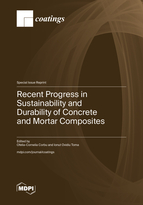Recent Progress in Sustainability and Durability of Concrete and Mortar Composites
A special issue of Coatings (ISSN 2079-6412). This special issue belongs to the section "Corrosion, Wear and Erosion".
Deadline for manuscript submissions: closed (31 July 2023) | Viewed by 19897
Special Issue Editors
Interests: eco-friendly building materials; sustainable concrete and mortar; green concrete; recycled aggregates concrete; alternative aggregates; concrete recycling supplementary cementitious materials; characterization of sustainable cementitious and alkali-activated materials; cement construction materials; nanomaterials; dispersed reinforcement; ultra-high-performance concrete; reinforced concrete/mortar properties; sustainability and environmental impact assessment of concrete materials; nondestructive testing
Interests: nanomaterials; sustainable concrete; supplementary cementitious materials; recycled aggregates concrete; behaviour of concrete at elevated temperatures; reinforced concrete structures
Special Issue Information
Dear Colleagues,
In civil engineering, the performance of structures is closely related to the performance of the construction materials, either in terms of strength or durability. After water, concrete is the second most used material worldwide and definitely one of the most versatile construction materials for structural applications. Another frequently met category of materials is those used for finishes and repair works, among which mortar is by far the material of choice in all its diversity in terms of composition and fields of application.
The ideal construction material should possess very high strength yet be flexible, should have a high durability and, at the same time, not harm the environment at all. Since their early days, cement-based materials have come a long way in terms of their strength and durability properties, their composition able to be tailored to address any specific needs posed by the construction sector. Perhaps one of the greatest advantages of cement-based materials, with emphasis on mortar and concrete, is their ability to incorporate a variety of wastes and industrial by-products and contribute to a cleaner tomorrow for future generations.
A lot of research effort is being invested in concrete with recycled aggregates coming either from the construction industry or other industry branches. Supplementary cementitious materials are being widely used to partially replace cement to help lower the carbon footprint of the construction industry and, at the same time, obtain new types of concrete with improved durability properties. Recent advances in science and technology saw the application of nanomaterials in concrete and mortar with improved strength, durability and thermal and electrical conductivity. Self-healing cement-based materials and 3D-printing concrete pushed the boundaries of research to new horizons.
This proves that concrete and mortar, although regarded as traditional construction materials, still have a lot to offer in terms of their ability to meet every need the industry might have.
It is our pleasure to invite you to submit your research works addressing the topic of this Special Issue. They keywords should serve as a guideline and not as a list of limitations.
Dr. Ofelia-Cornelia Corbu
Dr. Ionut Ovidiu Toma
Guest Editors
Manuscript Submission Information
Manuscripts should be submitted online at www.mdpi.com by registering and logging in to this website. Once you are registered, click here to go to the submission form. Manuscripts can be submitted until the deadline. All submissions that pass pre-check are peer-reviewed. Accepted papers will be published continuously in the journal (as soon as accepted) and will be listed together on the special issue website. Research articles, review articles as well as short communications are invited. For planned papers, a title and short abstract (about 100 words) can be sent to the Editorial Office for announcement on this website.
Submitted manuscripts should not have been published previously, nor be under consideration for publication elsewhere (except conference proceedings papers). All manuscripts are thoroughly refereed through a single-blind peer-review process. A guide for authors and other relevant information for submission of manuscripts is available on the Instructions for Authors page. Coatings is an international peer-reviewed open access monthly journal published by MDPI.
Please visit the Instructions for Authors page before submitting a manuscript. The Article Processing Charge (APC) for publication in this open access journal is 2600 CHF (Swiss Francs). Submitted papers should be well formatted and use good English. Authors may use MDPI's English editing service prior to publication or during author revisions.
Keywords
- concrete and mortar design
- component materials of composites
- cement construction materials
- supplementary cementitious and alkali-activated materials
- nanomaterials
- reinforced concrete/mortar properties
- self-healing materials
- eco-efficient cementitious composites
- low carbon footprint
- life cycle
- nondestructive testing
- asphalt concrete







